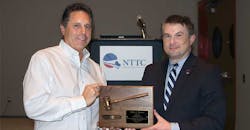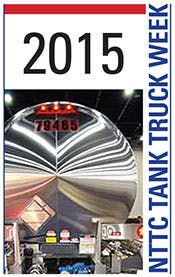NTTC’s Liquid Products Database making steady progress
NATIONAL Tank Truck Carriers’ Liquid Products Database has made steady progress since its introduction two years ago, but more work is needed to fully achieve the potential of the online tool for determining the tank corrosion potential of various chemical cargoes.
Most importantly, the LPD needs to continue expanding its database of chemical blends. Members of the LPD Steering Committee said during NTTC’s 2015 Tank Truck Week in Houston, Texas, that they want to cast a wide net to identify the corrosion properties of as many blends as possible.
NTTC is asking carriers to suggest “proprietary blends” for future testing of corrosive properties by Battelle, the world’s largest nonprofit research and development organization.
NTTC has developed a protocol for laboratory testing of these proprietary blends that are done at Battelle. The first test was on 48% aluminum sulfate. There are two test sizes: a smaller coupon for quantitative evaluation, and after 30 days Battelle assesses how much of the mass still remains so it can assign a corrosion rating; and a larger coupon that has an O-ring for qualitative analysis after 30 days, when they can identify any signs of pitting, crevice corrosion, or other things that would be problematic.
Battelle has a mechanism to heat the solution to 120 degrees F to replicate conditions a tank truck would face.
“The smaller coupons are submerged in aluminum sulfate,” Cannon said. “Battelle also has a highly sophisticated drying tree so three times a week, the coupons can be dried to simulate what would happen after unloading.”
Cannon said caustic soda, which is commonly hauled by stainless steel tanks, requires carriers to “peel the onion a bit more.”
“One of the most common ways to make caustic soda is using sodium chloride in combination with water and electrical energy to form chlorine gas and caustic soda,” he said. “Any residue still in the solution is an opportunity for a corrosion problem in your tank. Chlorides plus time plus temperature equals pitting. So any time you’re asked to haul caustic soda, peel the onion.”
Case Study
Craig Casey, director of maintenance
Tankstar USA
Casey said the Liquid Products Database has 6,000 entries in it, but needs 50,000.
It’s important that data is extracted, but he said it’s frustrating and sometimes comical trying to get information from a shipper.
He presented a case study in which communication started in May 2015 between a shipper and carrier on “Proprietary Blend 1,” specifically related to chloride content. In September 2015, an internal memo was sent because nobody from the shipper had provided the product information.
That triggered an email in which one representative said he had pulled up the MSDS for “Proprietary Blend 1.” And he could see “no requirement for a lined bulk trailer which would trigger the request for the chloride levels.” An email was then sent to the carrier asking, “Can you please provide details around the request, including your company’s relationship with our enterprise?”
The carrier emailed back, “We already have your Safety Data Sheet. My boss wants to know if there are chlorides present, and if so, what is the percentage of chlorides by weight? Or, he would make do with a Technical Data Sheet if you don’t have that information available.”
After the shipper once again asked the carrier to identify the relationship between the companies, the carrier wrote, “At this time I don’t believe we have one. We usually don’t bid on a job without more information on the product we’re transporting.”
The shipper emailed back, “Our company does not typically provide product composition information. The MSDS sheet should be sufficient at this time. We have contracted with a third-party logistics company to arrange transportation. If there is an immediate or future opportunity for us to work with your firm to haul this product, that you and I are not yet aware of, we can revisit.”
Said Casey, “Many of you in the room have similar stories. This is not an isolated occurrence. I sent this email to the steering team and I could almost hear everybody chuckle. Somebody wrote back and said, ‘Same answer I got.’ So it happens way too often.
“We don’t want to steal anybody’s trade secret. We are interested predominantly in halite content and whether or not we’re going to have pitting problems in our trailers. So we need to work with Battelle, which is a nonprofit, scientific organization, and neutral. They don’t care. All they’re doing is reporting the facts, ma’am. We’d like to see a relationship to develop between the American Chemical Council and Battelle so we can have some non-disclosure agreements where they could get this information, hold it in trust, and be able to report just the piece or pieces we need to make good, informed decisions.”
Current Affairs: Corrosion in a Heat Panel
Ian Haggerty, research scientist
Battelle
Haggerty presented an example of a recent episode in which a carrier sent a heat panel to an independent lab to have it analyzed to find out why a tank had this failure.
The verdict of a metallurgist hired by the carrier: “We respectfully recommend that steam chemistry is controlled and prevent chlorine from getting into the steam circuit. Chlorine typically enters from acid cleaning, disinfecting or using chlorine–contaminated water in the steam circuit. Chlorine must be kept below the ppm range for steam temperatures to prevent stress corrosion cracking.”
Haggerty said there are three conditions necessary for Stress Corrosion Cracking (SCC) to occur: susceptible material; corrosive environment (such as the presence of chlorides in solution); or tensile stresses present (either residual or external).
“When chloride SCC does occur, the failure is usually sudden and without warning,” he said.
“For sensitization to occur, chromium needs to be depleted from grain boundaries. In this case, the Type 201 SS is more susceptible to this phenomenon than Type 316L due to chemical composition differences. As a result, Type 201 has a lower corrosion resistance. This can lead to intergranular attack (IGA), or along grain boundaries, in a corrosive environment. Sensitization is typically a gradual failure mode.”
He said SCC is primarily a transgranular (through the grains) phenomenon. Sensitization proceeds along grain boundaries. The Heat Affected Zone (HAZ) of a weldment is often the site of sensitization.
“It’s always a good idea to minimize the presence of chlorides in solutions when in contact with stainless steels,” he said. “Elevated temperatures lead to corrosion (SCC or otherwise) much more quickly than at room temperature.”
New Liquid Products Database Website
Doug Pape, senior research engineer
Battelle
Pape said the new website, Lpdbat.azurewebsites.net, is free for now, but will soon be by subscription only.
It is maintained by Battelle under a contract with NTTC. The purpose is to provide objective information to carriers on the corrosive properties of liquid products that they might haul. The database is currently limited to corrosion properties on Type 316 stainless steel and on Lean Duplex (LDX) 2101.
Information in this database comes from three sources: data available in published sources; information contributed by carriers; measurements made by Battelle at the request of carriers.
Questions should be emailed to [email protected]. ♦
About the Author
Rick Weber
Associate Editor
Rick Weber has been an associate editor for Trailer/Body Builders since February 2000. A national award-winning sportswriter, he covered the Miami Dolphins for the Fort Myers News-Press following service with publications in California and Australia. He is a graduate of Penn State University.

